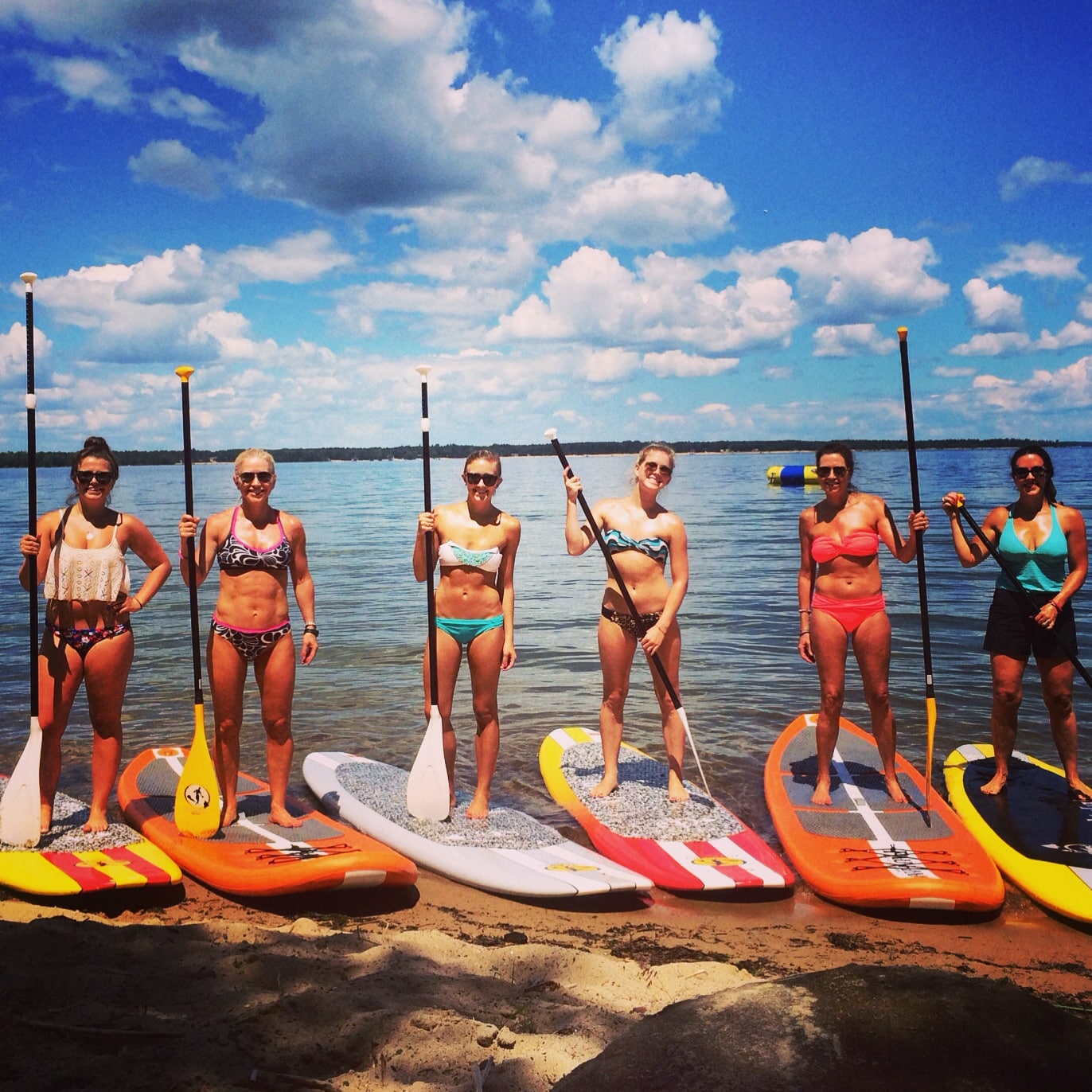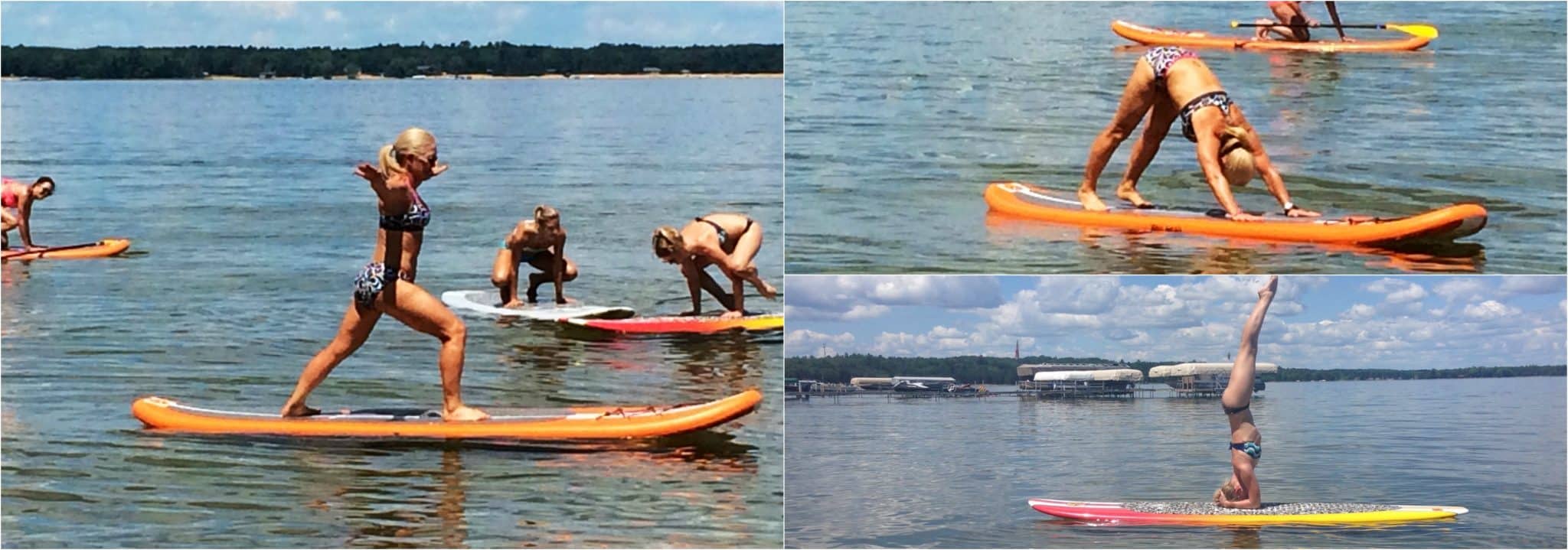This post contains affiliate links. Please see our disclosure policy.
If you’re new to paddleboarding—SUP for short—welcome! In this guide, you will learn how to paddleboard and why it’s not only fun but an effective workout!
Skyrocketing in popularity since the early 2000s, paddle boarding is an excellent form of exercise that all ages and fitness levels can enjoy. It doesn’t take as much skill or balance as you might think. All you need in order to learn how to paddleboard is a calm body of water and some basic technique.
Table of contents
Health and Wellness Benefits Of Paddleboarding

Why stand-up paddleboard when you could run, bike, or swim? Here are just a few of the health and wellness benefits that make stand-up paddleboarding an amazing activity and effective workout!
Provides A Full-Body Workout
First, paddle boarding provides an amazing full-body workout. Your legs are engaged to keep you balanced on the board. Your core is pulled in tight for added stability. Your upper body is paddling you through the water to strengthen your shoulders, arms, and upper back – it truly covers you in strength from head to toe!
Improves Your Balance and Stability
Balance and stability tend to decrease as we age. Ironically, that’s just when we need it the most. Paddleboarding requires balance from the moment you step on the board until the moment you get off. So the more you paddle bard, the better your stability will become.
Gives You A Cardio Fix
Once you get strong enough to stay up longer on the paddleboard, you’ll also find yourself wanting to move more on it which will get your heart rate up in the process. The SUP is one of those awesome activities that provide both strength and cardio all in one.
Paddle Boarding Is A Low Impact Workout
Paddleboarding is an excellent way to work out without putting so much stress on your joints, especially the knees, hips, and lower back.
Strengthens Your Core and Lower Back
Speaking of your lower back, paddle boarding required that you pull in your abdominals in order to stabilize and keep from tipping over. This gives you a stronger middle which includes a better lower back. With a strong lower back you can expect fewer injuries and less back pain.
Paddleboarding Relieves Stress
Breathe deep and enjoy the sensation of skimming across the water. Soaking in the sunshine and the sounds of the birds and nature is one of the best ways to relieve stress and clear your head.
How to Find The Right Paddleboard

Let’s start with the biggest piece of the paddleboarding puzzle: the board.
For most of you, fun and fitness are the main goals, and not racing which requires a different shape and length board altogether.
Some come in bright colors, some are lighter to carry down to the beach, and some are better for transporting in a car with ease.
Medium-Length Paddleboards
Medium-length paddleboards measure between 9’ and 12’ with a planing hull (vs a displacement hull) and are great for all-around use on calm lakes and in small waves according to REI experts.
My family owns three 11’ and one 10’ Hulakai board. The 11’ is just a little more stable.
Inflatable Paddle Boards
We own two inflatable boards that are amazing. I will go on record saying they are the bomb! I ordered off eBay from a company close to home in St. Paul, MN.
Flash forward a year, and there are hundreds of options online. They literally fit in a backpack, so you don’t have to worry about transportation. When you get to the lake or beach, you just blow them up with a pump, and off you go.
These are the Top Rated Inflatable paddleboards:
I recommend an electric pump, but the hand pump works just fine too and we actually use that the most often. It takes about 10 minutes to blow up which is no problem. The inflatable board feels exactly like a normal paddleboard. My family and friends literally can’t tell the difference.
You can also talk to a stand-up paddleboard expert before you purchase. I personally trust the experts at sites like Hulakai and Isle Surf and SUP to find the right board.
Choosing Your Paddle Length

The paddle is used to propel the board through the water. A paddle that is too short or too long will stunt your ability to maneuver your paddleboard with ease.
A good rule of thumb when picking a paddle:
- For Racing: your paddle should be 10-12 inches taller than you
- For recreational cruising on flat water: your paddle should be 8-10 inches taller than you
- For surfing: your paddle should be 6-8 inches taller than you
- For the majority of those reading, go with the cruising height!
If you’re buying a paddle or two for the whole family, an adjustable paddle is a smart bet.
Related: The Beginner’s Guide To Your First Spin Class
More Paddleboarding Gear

Safety Gear
Life Jacket The US Coast Guard requires that all paddleboarders must wear a life jacket or have it with them on his or her board.
Safety Survival Whistle The Coast Guard also requires that you carry a safety whistle to warn other boaters.
What To Wear Paddleboarding
Depending on the weather or whether or not you plan on jumping in, your activewear can vary. You can wear just a bathing suit, a bathing suit and rash guard combo, or just workout clothes. Here are some of my favorites to wear when I’m on the paddleboarding:
- Water Sports Shoes
- Long Sleeve UV Sun Protection Wetsuit Swimsuit Top
- Quick Dry Shorts With Zipper Pockets
- UPF Baseball Hat
These are my favorite picks for the best bathing suits for women over 50.
Sun Protection
Sun beating down on water is just asking for a sunburn. Stay safe with water-resistance sport sunscreen, a hat, and sunglasses. If you go for a swim, the hat and sunglasses will stay safe and sound on the board.
Paddleboarding Technique And Form

Starting Position
Option 1:
- Pull your board out into shallow water, lay your paddle on the board, and carefully climb on. Start paddling from your knees for a few strokes.
- Then, carefully stand up one foot at a time until you are situated in the middle of the board with your feet hip-width apart and parallel.
Option 2:
- Pull your board out into shallow water that is deep enough for your bottom fin to be free.
- Stand with your feet evenly placed. Utilize a hand from a friend to get into this position if it’s your first time.
- You should be standing about one or two step back from the center of the paddleboard.
As you Paddle
- Always keep a slight bend in your knees, your toes pointed forwarded, and your eyes facing forward and not on your feet. This will help your balance!
- You should keep your arms straight and twist from your torso as you paddle. You have much more strength in your core muscles than in your arms.
- Stick the paddle in the water as far forward as possible, pull your paddle through the water to your ankles, and then lift it out of the water and repeat.
- Paddle four to five strokes on one side of the board and then switch to the other side in order to stay in a straight line.
Related: The Beginner’s Guide To Strength Training
Paddleboarding Exercises

If you want to take your SUP paddleboarding workout to the next level, put your paddle down and add in some strength moves on the board.
These are our favorite strength exercises and yoga poses to do floating on the water. SUP yoga is so popular right now, that you can easily find a class at your local beach or lake!
1. Basic Squats
2. Stationary Lunges
3. Russian Twists (holding the paddle)
4. Crescent Lunge
5. Down Dog
6. Warrior 2

How Hard Is It To Fall Off A Paddle Board?

Ahh, the question you’ve been dying to ask. Here’s the deal: unlike pool floaties, the boards are very sturdy. You can stand up, sit down, lie down, and paddle from your knees without falling in.
Paddle Boarding takes a little practice, and starting on your knees may help, but most folks get the hang in a few minutes.
If you do some yoga on your paddleboard might make you fall in 🙂
It’s not that it’s hard to do, it’s overcoming the fear. PS: It’s very easy to get back on the board from the water if you do take a dive!

Changing your workouts is important for the overall health of your body. One day is a run, the next day is weight lifting, and another day is paddleboarding. Change is good!
READ THIS NEXT: The Beginner’s Guide To Barre



Thank you for taking time to share with us this guide, it really helps me out to understand some Stand-Up Paddleboarding basic.
I like your explanation of not paddling with your arms but pulling your body towards the paddle. I teach many friends and family how to SUP and I’m definitely going to use this explanation. Thanks.